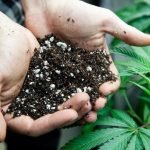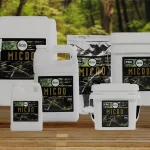All About Hydroponic Nutrients
nutrients for hydroponic systems
Growing hydroponically means growing your plant in water. There are several hydroponic systems, each working slightly differently. This is a great way to grow if you are not a fan of soil growing and allows you to have complete control over the climate and nutrients your plant receives.
You will want fertilisers that have been made specifically for hydroponic systems, to allow the pipes and mechanics of your system to remain clear from debris and clogs. They will also be water soluble.
What you should look for in a hydroponic nutrient for cannabis:
- One that has been designed for hydroponics
- Make sure magnesium, calcium, iron, and sulphur are included
- Includes lots of micronutrients (soil will naturally have these, so we need to add them for hydroponic solutions)
- Minerals with no organic matter added (which can start to grow unwanted things in the reservoir and disrupt the roots system)
- Includes chelated mineral nutrients, which help the plant to absorb minerals within a wider pH range
- Has the best NPK ratio for the specific growth stage
What to avoid:
You should avoid fertilisers that have been made specifically for soil. Also, any solutions that contain a lot of organic matter, such as worm castings or blood meal, will only clog up your system. This organic matter can also ruin the water in your reservoir, cause problems with the roots or even start to grow stuff in the water tank.

difference between hydroponic and soil nutrients
Fertilisers designed for hydroponics generally have slightly different NPK ratios. This is the percentage of nitrogen, phosphorus, and potassium in the nutrient solution. For example, an NKP ratio of 20-10-20, it means there will be 20% nitrogen, 10% phosphorus, and 20% potassium. You will need to check the ratio as this will change during each stage of plant growth.
Soil is usually much higher in nitrogen, as opposed to water solutions in hydroponics. For this reason, fertilisers for hydroponics tend to include higher levels of nitrogen. They also contain more micronutrients, that are naturally found in soil.
Hydroponic nutrients also have lower levels of phosphorus. This is because in soil, some microorganisms will use and absorb some of the available phosphorus in the soil, so more phosphorus is added to soil fertilisers to compensate. In hydroponics this is much less of a problem so there is no need to add the extra phosphorus.
Nutrients for hydroponics will normally include specially treated chelated minerals, to help the plant absorb all the nutrients. Organic matter is not added in hydro solutions as it can cause a problem if getting into the water tank of hydroponic systems. In a soil solution, there are microorganisms that can break down the organic matter, but not in hydroponics.

NPK ratio for each growth stage
When your seeds are sprouting, you do not need to add any nutrients, as this can overwhelm the plant, as they are not strong enough to take in large amounts of nutrients.
When you reach the vegetative stage, you will be able to start adding ‘vegetative’ nutrients. Your plants at this stage will need an equal amount of nitrogen, phosphorus, and potassium. Fertilisers high in both nitrogen and potassium, and medium to high on phosphorus, also work very well.
During the flowering stage, your plant will need less nitrogen, and high amounts of potassium and phosphorus. Fertilisers may be labelled as ‘bloom’ nutrients, which will help the growth and development of the flowers and buds.
Tip: Do not buy any slow release nutrients. These may work well in other garden plants, but they could produce a problem when growing cannabis, such as giving too much nitrogen in the flowering stage.

the pH level of your water
Monitoring the pH level of the water you give to your plants is just as important than ensuring you have the correct nutrients. Even with the right nutrients, your plant will not grow correct if it cannot take in the nutrients. When the pH level is not right, the plant will not be able to absorb the nutrients you give it.
In hydroponic systems, if the pH level sitting in the roots of the plant is incorrect, the chemical form of the various nutrient compounds can change, meaning the plant will find it harder to absorb the nutrients.
For hydroponics ensure the pH level of your water is around 5.5 to 6.5. If it gets to high or too low, it can cause a nutrient deficiency, so be sure to regularly check the pH level of your reservoir. Always add the nutrients to your water first, as this can change the pH level, and then test the water with a digital pH pen. To lower or higher the level, add in either a ‘pH up’ solution or a ‘pH down’ solution, and test again.

using a hydroponic fertiliser
If starting out, always start using around half or even 25% of the recommended solution to test it out first. If your plants have a pale colour, slowly add the nutrients until reaching the recommended dose and when your plants are looking healthy and growing well.
Keep in mind that fertiliser guidelines on the back of the bottle may actually recommend a higher dose of the fertiliser, so start slow, to avoid nutrient burn. Also, your water should sit at around 15.5 to 20 degrees Celsius, when using nutrient solutions.
Keeping checking your plants, nutrients and pH levels regularly to ensure your plant is doing well and you are not over/under feeding.

Our deep love of plants and fascination with Cannabis has enabled over 25 years of successful small scale Marijuana cultivation from indoor hydroponics, greenhouses and outdoor growing set-ups.
As Cannabis laws around the world change, *we support the movement toward freedom of choice for responsible, consenting adults who wish to experience the joy and wonder of growing a Cannabis plant.


